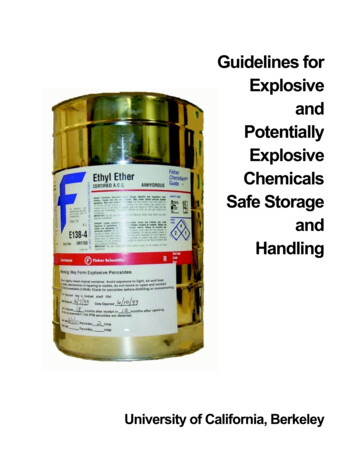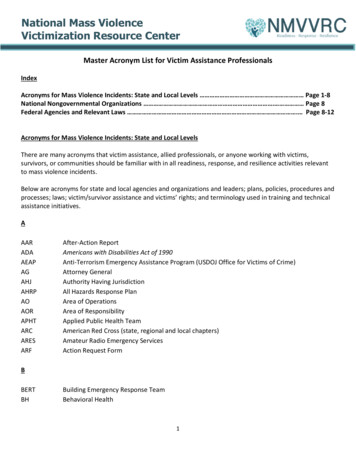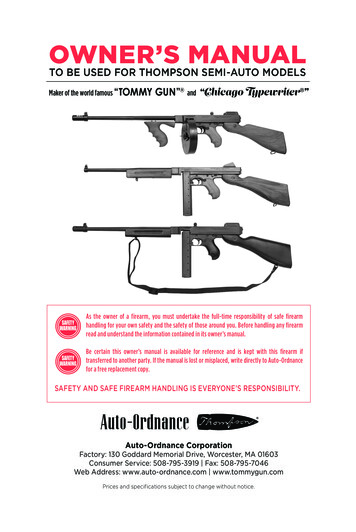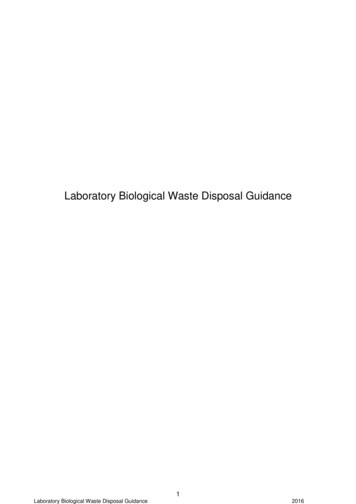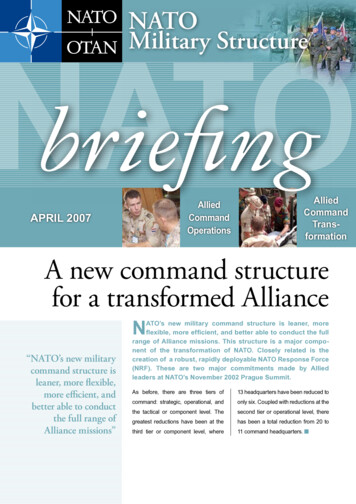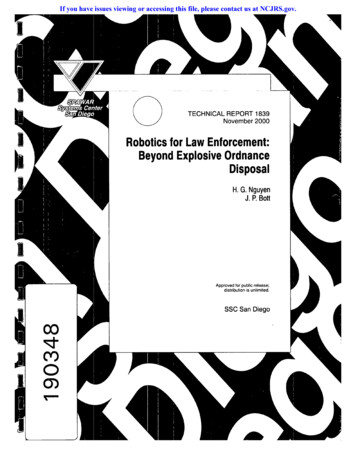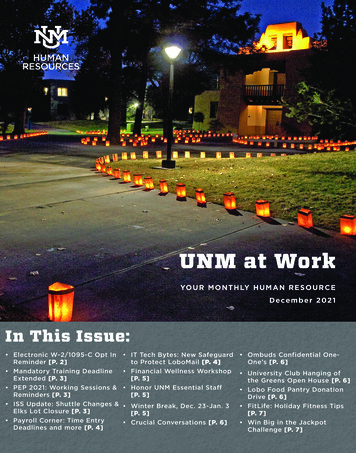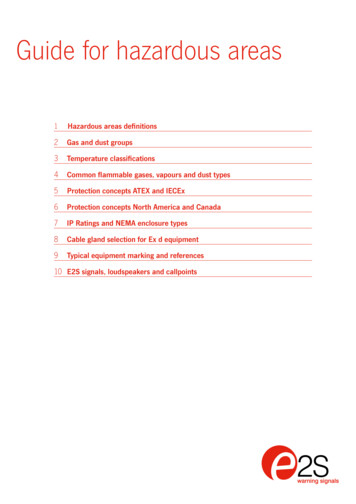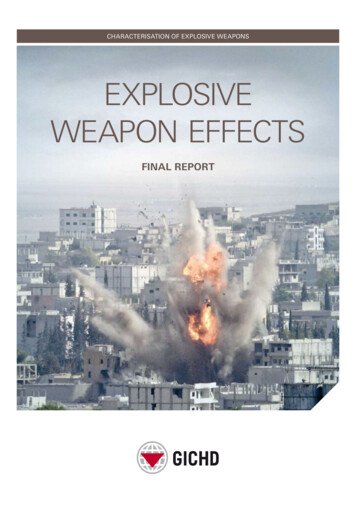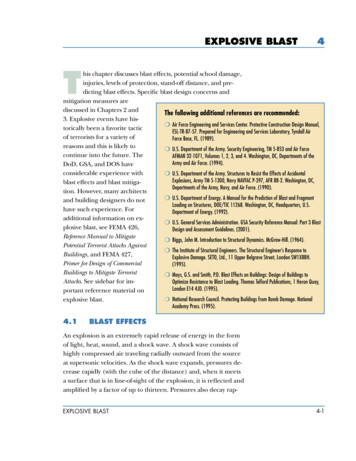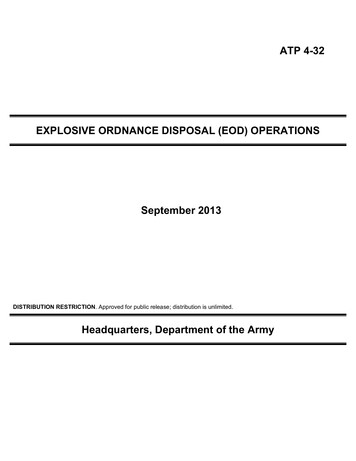
Transcription
ATP 4-32EXPLOSIVE ORDNANCE DISPOSAL (EOD) OPERATIONSSeptember 2013DISTRIBUTION RESTRICTION. Approved for public release; distribution is unlimited.Headquarters, Department of the Army
This publication is available at Army Knowledge .html).To receive publishing updates, please subscribe athttp://www.apd.army.mil/AdminPubs/new subscribe.asp.
*ATP 4-32(ATTP 4-32)HeadquartersDepartment of the ArmyWashington, DC, 30 September 2013Army Techniques PublicationNo.4-32EOD OperationsContentsPagePREFACE.ivINTRODUCTION .vChapter 1EXPLOSIVE ORDNANCE DISPOSAL . 1-1Mission Statement . 1-1Organization . 1-2Army National Guard . 1-7EOD Team Leader Certification . 1-7EOD Staff Officer/Non-Commisioned Officer . 1-8Joint Operational Phasing Construct . 1-8Chapter 2CONTINGENCY OPERATIONS . 2-1The Operational Environment . 2-1Group and Battalion Operations . 2-2Command and Support Relationships. 2-3Joint and Multinational Operations . 2-3Counter-IED Operations . 2-4Company and Platoon Operations . 2-4EOD Team Operations . 2-11Chapter 3DEFENSE SUPPORT OF CIVIL AUTHORITIES . 3-1Group and Battalion. 3-1Company Command Section . 3-2Company Operations Section . Error! Bookmark not defined.EOD Team Response . 3-6Very Important Persons Protection Support Activity . 3-8Mission Receipt . 3-8Pre-Mission Preparation . 3-9Mission Execution. 3-9Post Mission Actions . 3-10Chapter 4SUPPORT TO SPECIAL OPERATIONS FORCES . 4-1Distribution Restriction: Approved for public release; distribution is unlimited.*This publication supersedes ATTP 4-32 dated 19 December 2011.i
ContentsOperational Environments . 4-175th Ranger Regiment (Airborne) . 4-4Special Forces Groups (Airborne) . 4-4Chapter 5CHEMICAL, BIOLOGICAL, RADIOLOGICAL, AND NUCLEAR OPERATIONS5-1Chemical, Biological, Radiological and Nuclear Threats And HazardsResponse . 5-1Nuclear Accident and Incident Response and Assistance . 5-8Respond to a Radiological Attack . 5-12Respond to Depleted Uranium Incidents . 5-12Appendix AEOD PRE-COMBAT CHECKLIST FOR MOUNTED OPERATIONS . A-1Appendix BEOD PRE-COMBAT CHECKLIST FOR DISMOUNTED OPERATIONS . B-1Appendix CSUPPORTING ORGANIZATIONS . C-1Appendix DCONTAMINATION/DECONTAMINATION STATION SETUP . D-1GLOSSARY . Glossary-1REFERENCES. References-1INDEX . Index-1FiguresFigure 1-1. EOD group . 1-3Figure 1-2. EOD battalion . 1-4Figure 1-3. EOD company . 1-5Figure 1-4. EOD platoon . 1-6Figure 1-5. EOD company WMD . 1-6Figure 1-6. EOD company (CONUS Support) . 1-7Figure 1-7. Example of duty status and command relationships (ADP 3-28) . 1-7Figure 1-8. EOD support across the joint phasing model . 1-9Figure 2-1. Communication architecture . 2-6Figure 2-2. Lightweight metal detector. 2-14Figure 2-3. 0/5/25 meter check . 2-17Figure 2-4. Inner and outer cordon . 2-18Figure 2-5. Inner cordon with wedge formation . 2-19Figure 2-6. Inner cordon in urban area . 2-20Figure 2-7. Circle search pattern . 2-24Figure 2-8. Strip/lane search pattern . 2-24Figure 2-9. Zone search pattern . 2-25Figure 2-10. Grid search pattern . 2-25Figure 2-11. Scene sketch . 2-26Figure 4-1. SOF EOD Mission Space . 4-2Figure 5-1. Example downwind hazard prediction area. 5-4Figure 5-2. Example emergency personnel decontamination station (EPDS) . 5-8iiATP 4-3230 September 2013
ContentsFigure 5-3. Example modified emergency personnel decontamination station (EPDS) . 5-8Figure 5-4. Emergency contamination control station (ECCS) . 5-12TablesTable 1-1. EOD group within theater area of operation . 1-3Table 1-2. No EOD Group within Theater Area of Operation. 1-4Table 1-3. No EOD group or battalion within theater area of operation . 1-5Table 2-1. EOD 9 Line . 2-930 September 2013ATP 4-32iii
PrefaceThis manual focuses on EOD techniques which have either been developed or changed significantly over thepast 11 years. Modularity has created exponential growth of EOD forces in an extremely short amount of time.Rules of allocation for EOD companies have continually changed to adapt to the current fight and ensure thatEOD forces remain relevant. This publication provides Army EOD the opportunity to capture into a singledocument the most successful techniques available to perform EOD tasks and effectively complete missions.ATP 4-32 is a sole source documented explanation of EOD mission sets throughout the full range of militaryoperations. The publication covers support provided to combatant commanders on counter terrorism andirregular warfare. EOD forces are a key enabler to deter and defeat aggression, project power despite antiaccess/area denial challenges, counter weapons of mass destruction, and maintain a safe, secure and effectivenuclear deterrent. EOD also supports civil and federal authorities in the defense of the homeland. Most stability,counter-insurgency, humanitarian, and disaster relief operations will require EOD support. This ATP distillspublic laws and regulatory guidance that specifically direct the Services EOD mission sets and providescoherent Army doctrine for EOD in unified land operations.ATP 4-32 provides doctrinal guidance for EOD commanders and Soldiers responsible for all EOD operations.Commanders and staffs of Army headquarters serving as joint task force or multinational headquarters shouldalso refer to applicable joint, multiservice or multinational doctrine concerning EOD operations. Trainers andeducators throughout the Army will also use this manual.Commanders, staffs, and subordinates ensure their decisions and actions comply with applicable United States,international, and in some cases, host-nation laws and regulations. Commanders at all levels ensure theirSoldiers operate in accordance with the law of war and the rules of engagement. (See Field Manual [FM] 2710).ATP 4-32 applies to the Active Army, the Army National Guard(ARNG)/Army National Guard of the UnitedStates (ARNGUS), and the United States Army Reserve (USAR) unless otherwise stated.The United States Army Training and Doctrine Command is the proponent for this publication. The preparingagency is the G3 Doctrine Division, USACASCOM. Send comments and recommendations on a DA Form2028 (Recommended Changes to Publications and Blank Forms) to Commander, U.S. Army Combined ArmsSupport Command and Ft. Lee, ATTN: ATCL-TSD, 2221 A Avenue, Fort Lee, VA 23801, or submit anelectronic DA Form 2028 by e-mail to livATP 4-3230 September 2013
IntroductionATP 4-32, EOD Operations, is the first EOD doctrinal publication released under Doctrine 2015. This ATP isconsistent with the doctrine of unified land operations found in ADP 3-0. ADP 3-0 shifted the Army’soperational concept from full spectrum operations to unified land operations.ATP 4-32 discusses best practices and techniques developed by EOD technicians and made changes from thenow obsolete 2011 ATTP 4-32. The most significant changes are the discussions on EOD support to specialoperations forces (SOF) and EODs role in the joint phasing model. This manual also addresses how EODprovides support throughout unified land operations. As discussed in ADRP 3-0, the doctrine of unified landoperations describes how the Army demonstrates its core competencies of combined arms maneuver and widearea security through decisive action. EOD techniques used to simultaneously support decisive action arediscussed throughout the manual. ATP 4-32 does not introduce, rescind or modify any new terms.Chapter 1 provides leaders a quick tutorial on EOD roles, organization and capabilities to defeat explosiveordnance, and briefly describes EOD mission sets in planning for each phase of the combatant commander’sjoint phasing model. The combatant commander’s respective deliberate plans contain detailed EOD planningand operational information.Chapter 2 describes and documents the “best practices” utilization of the EOD sustainment function duringcrisis response and limited contingency operations. It provides unclassified lessons learned from the last 12years of conducting EOD tasks on offensive, special operations, intelligence, protection and homeland defenseand defense support to civil authorities (DSCA).Chapter 3 explains the “how to” of EOD tasks for DSCA in support of combatant commanders and civilauthorities. It emphasizes tasks that both active and reserve component EOD units perform in direct support ofcivilian law enforcement agencies on a daily basis.Chapter 4 provides doctrine on EOD tasks to support Special Operations during special warfare, sharedactivities and surgical strike operations. It describes Army EOD’s globally provided support of combatantcommander response forces, special mission units, special forces groups (airborne) and the 75th RangerRegiment (Airborne).Chapter 5 provides doctrine on EOD operations for combating weapons of mass destruction (WMD). Thesehighly technical EOD operations are guided by and documented in classified technical manuals with validatedrender safe procedures. EOD units are uniquely qualified to conduct classified counter-WMD operations as allEOD Soldiers possess top secret security clearances with critical nuclear weapon design information access.30 September 2013ATP 4-32v
This page intentionally left blank.
Chapter 1Explosive Ordnance DisposalExplosive ordnance disposal (EOD) is a key asset in the protection of military andcivilian personnel, critical assets, infrastructure, and public safety. Ordnance andexplosive threats are present during all phases of joint operations. In order to manageand mitigate risk at the lowest possible level, commanders must integrate EODduring the planning and the simultaneous execution of combined arms maneuver andwide area security.MISSION STATEMENT1-1. Provide EOD support to unified land operations by detecting, identifying, conducting on-siteevaluation, rendering safe, exploiting, and achieving final disposition of all explosive ordnance, includingIED and weapons of mass destruction (WMD); provide support to joint, interagency, intergovernmentaland multinational operations as required.1-2. EOD supports the combatant commander’s capability to protect the force within the followingprinciples as outlined in Army doctrine reference publication (ADRP) 3-37, Protection: Comprehensive. EOD expertise provides a complete capability to identify, render safe/dispose,and exploit all facets of explosive ordnance to include US and foreign unexploded explosiveordnance (UXO), IEDs, and WMD. The adaptable force structure enables EOD to assumemission command of all like capabilities and enablers that counter and exploit the explosiveordnance and IED threat. Integrated. This crucial capability readily integrates within other protection capabilities such asproviding exploitation products to support rule of law efforts, or rendering safe and supportingexploitation of WMD materials in support of CBRNE response teams. This expertise is alsointegrated into a combatant commander’s formation by an adaptable and scalable forceallocation system, providing key counter explosive ordnance enabler capabilities at all maneuverechelon levels vertically from corps to battalion and in both conventional forces and in supportof special operations. Layered. Protection from all facets of UXO, IED, and WMD comes within a layered approach.EOD can provide recurring training to the general force in how to recognize and react toencountered threats and advise physical security plans how to protect critical facilities fromexplosive threats; EOD teams perform render safe and disposal of encountered threats; and thenwith support from other specialized enablers conduct collection and exploitation of recovereditems and components that support intelligence and targeting processes. Redundant. The robust force structure of the EOD organization provides a redundancy ofcapability both vertically and horizontally within maneuver forces, with a force allocation planof both direct support and general support EOD teams. Strategically, a significant ArmyNational Guard EOD force structure provides a considerable reserve capability that can befocused on secondary priorities and fill requirement gaps for the active force. Enduring. The EOD force is a crucial asset within all aspects of unified land operations andwithin the entire cycle of joint force operations. Providing EOD expertise during military tomilitary engagements, humanitarian demining action, and other theater security cooperationprogram engagements is a key component of a combatant commander’s Phase 0/I Shaping andDeterrence operations. During Phase II-IV EOD provides critical protection capabilities fromexplosive ordnance threats and supports the identification and targeting of enemy networks thruexploitation of captured material. In the stabilization and enabling phases, security forceassistance operations to build partnered nations military and civil EOD/counter-IED resources30 September 2013ATP 4-321-1
Chapter 1become the priority. Additionally, EOD forces are essential to the continuing homeland defensemission and providing routine support to civil authorities; providing on and off installationsupport to federal, state, local public safety officials to render safe explosive ordnance/IEDs andsupport to the Secret Service and Diplomatic Security Service for the protection of veryimportant persons.ORGANIZATION1-3. The EOD group and battalion commands and staffs may exercise synchronized mission command ofArmy, joint, and multinational EOD forces. Senior EOD personnel can provide the expertise to plan,prepare, execute, assess and integrate external EOD formations into the supported unit.1-4. EOD provides the supported commander the capability to render safe and dispose of all explosiveordnance, to include UXO, IEDs and improvised explosives. The ability to render safe explosive ordnanceis essential in providing intelligence to target IED networks, as well as update TTPs, both enemy andfriendly. EOD personnel have the ability to dispose of all types of ordnance in the safest manner possible.Ordnance that is disposed of improperly can cause damage to both military and civilian personnel andproperty within the blast and fragmentation zone.1-5. EOD commanders and staffs from group to platoon provide the supported commander and staff notonly mission command of EOD subordinate units, but also other specialized enablers such as technicalintelligence and exploitation assets focused on weapons and ordnance. They also provide a special staffcapability and subject matter expertise concerning all facets of explosive ordnance, IEDs, CBRN/WMDthreats and hazards, and technical exploitation. The EOD leadership and staff can support or provide stafflead of functional working groups (e.g. counter-IED), integrated into supported unit staff planningprocesses, provide support and input into targeting and the intelligence process, and lead exploitationactivities and processes.EOD GROUP1-6. The EOD group is a functional mission command headquarters for EOD operations. The groupconducts staff planning and technical control of all EOD assets in a theater and provides EOD staff liaisonto the ASCC. The EOD group is capable of conducting EOD mission command for two to six EODbattalions. The EOD group is attached or placed OPCON, to coordinate counter-IED and weaponstechnical intelligence operations, to a theater army, corps, or JTF in support of a specific operation,operation order, operation plan, or concept plan. The group may also form the core of a specializedcombined JTF with mission of various protection and exploitation enablers such as counter-IED,exploitation, or counter-WMD task forces. The group can also provide enabling support, analysis, andadvisement to execute targeting efforts, theater exploitation, and counter-WMD in order to providemaneuver support and force protection in all operational environments.1-2ATP 4-3230 September 2013
Explosive Ordnance DisposalFigure 1-1. EOD groupTable 1-1. EOD group within theater area of operationEODOrganizationModeling Rule ofAllocationSupported OrganizationRelationship1 per Theater Army1 per Corps1 per Joint TaskForce1 per CombinedJoint Task Force1 per HomelandDefense1 per 2-6 EODBattalionsTheater ArmyCorpsJoint Task ForceCombined Joint Task ForceAttached/OPCONAttached/OPCONOPCONOPCON1 per Division1 per Joint TaskForce1 per CombinedJoint Task Force2 per HomelandDefense1 per 3-7 EODCompaniesEOD GroupDivisionJoint Task ForceCombined Joint Task ForceOPCONDS/GSDS/GSDS/GS1 per BCT1 per SFG(A)1 per RangerRegiment8 per HomelandDefense1 per 1-5 EODPlatoonsEOD BattalionBCTMEBSFG(A)Ranger RegimentOPCONDS/GSDS/GSOPCON/TACONOPCON/TACON3 Per committedBCT1 per Special ForcesBattalion1 per RangerEOD CompanyManeuver BattalionSpecial Forces BattalionRanger BattalionAssignedDS/GSDS/GSDS/GS30 September 2013ATP 4-321-3
Chapter 1Table 1-1. EOD group within theater area of operationEODOrganizationModeling Rule ofAllocationBattalion24 per HomelandDefense1 per 3 EOD TeamsSupported OrganizationRelationshipEOD BATTALION1-7. The EOD battalion is a functional mission command headquarters for EOD operations. The EODbattalion conducts staff planning, staff control of all counter-IED assets within a division area ofoperations. The EOD battalion is capable of conducting EOD mission command and supervision of EODoperations for two to seven EOD companies. The EOD battalion may be attached or OPCON to a theaterarmy, corps, division, JTF, or CJTF in support of a specific operation, operations order, operation plan, orconcept plan.Figure 1-2. EOD battalionTable 1-2. No EOD Group within Theater Area of OperationEODOrganization1-4Modeling Rule ofAllocationSupported OrganizationATP 4-32Relationship30 September 2013
Explosive Ordnance Disposal1 per Division1 per Joint TaskForce1 per CombinedJoint Task Force2 per HomelandDefense1 per 3-7 EODCompaniesTheater ArmyCorpsDivisionJoint Task ForceCombined Joint Task ForceAttached/OPCONOPCONOPCONOPCONOPCON1 per BCT1 per SFG(A)1 per RangerRegiment8 per HomelandDefense1 per 1-5 EODPlatoonsEOD BattalionBCTMEBSFG(A)Ranger RegimentOPCONDS/GSDS/GSOPCON/TACONOPCON/TACON3 Per committedBCT1 per Special ForcesBattalion1 per RangerBattalion24 per HomelandDefense1 per 3 EOD TeamsEOD CompanyManeuver BattalionSpecial Forces BattalionRanger BattalionAssignedDS/GSDS/GSDS/GSCOMMAND AND SUPPORT RELATIONSHIP1-8. The EOD group or battalion may deploy as the senior mission command element for EOD operationsand may be organized under a theater army, corps, division, JTF or CJTF. The EOD battalion reportsdirectly to the EOD group and may deploy with its assigned EOD group or may have OPCON designatedto a separate EOD group.EOD COMPANY1-9. The EOD company provides mission command of one to five EOD platoons and providesadministrative company level planning and support based on the level of employment to includeaugmenting the brigade combat team (BCT) commanders with a special staff element. The EOD companyprovides EOD service throughout the theater AO and direct support to designated BCT/SFG(A).Figure 1-3. EOD companyTable 1-3. No EOD group or battalion within theater area of operationEODOrganizationModeling Rule ofAllocation30 September 2013Supported OrganizationATP 4-32Relationship1-5
Chapter 11 per BCT1 per SFG(A)1 per RangerRegiment8 per HomelandDefense1 per 1-5 EODPlatoonsBCTSFG(A)Ranger RegimentOPCONOPCON/TACONOPCON/TACON3 Per committedBCT1 per Special ForcesBattalion1 per RangerBattalion24 per HomelandDefense1 per 3 EOD TeamsEOD CompanyManeuver BattalionSpecial Forces BattalionRanger BattalionAssignedDS/GSDS/GSDS/GSEOD PLATOON1-10. The EOD platoon is normally employed at the battalion level and provides leadership, supervisionand technical guidance for three to four EOD teams, typically consisting of three personnel. The EODplatoon provides the capability to eliminate and reduce explosive, chemical, biological, and nuclearhazards, including IEDs and conventional U.S. and foreign UXO. The platoon provides support to the USSecret Service and Department of State in protection of the President, Vice President and other dignitariesas directed.Figure 1-4. EOD platoonEOD COMPANY WMD1-11. The EOD WMD company provides highly technical EOD operations and containment procedures forWMD in support of joint or interagency operations. It has the ability to respond anywhere in the world withtwo fully capable eight person platoons as part of the Joint Technical Operations Team to defeat or mitigatethe effects of WMD against the US. The unit has the capability to provide four WMD platoons to supportthe Army or other US agency in support of missions to defeat or mitigate WMD directed against the US ornational interest.Figure 1-5. EOD company WMD1-6ATP 4-3230 September 2013
Explosive Ordnance DisposalEOD COMPANY (CONUS SUPPORT)1-12. The EOD company (CONUS Support) provides EOD service in the reduction and elimination ofhazardous munitions and explosive device services to federal, state, and local agencies on an area basis.The EOD (CONUS support) Company is allocated based on the concept of support requirements.Dependent on the ordnance battalion EOD for administrative, CBRN, religious, legal, personnel, fieldfeeding, and supply services/support, the subordinate elements of the support maintenance company toperform field maintenance on the unit’s organic equipment and the area support medical company for forcehealth protection and Class VIII support.Figure 1-6. EOD company (CONUS Support)ARMY NATIONAL GUARD1-13. Administered by the National Guard Bureau (a joint bureau of the departments of the Army and AirForce), the Army National Guard (ARNG) has both a federal and state mission. The dual mission, aprovision of the US Constitution and the US Code of laws, results in each Soldier holding membership inboth the National Guard of his or her state and in the US Army. ARNG EOD assets are resident withinseveral states and the Commonwealth of Puerto Rico.1-14. In addition to ARNG deployments in support of federal missions, the ARNG plays an extensive andhighly visible domestic role. As part of its unique “dual-mission” responsibilities, the ARNG routinelyresponds to domestic requirements within each state. Whenever disaster strikes or threatens, the ARNGrepresents the most significant asset governors can rapidly mobilize to provide protection, relief, andrecovery. In accordance with the applicable laws, Department of Defense Policies and Department ofDefense Directives, the ARNG may provide support of special events and defense support and assistance tocivilian law enforcement agencies. Figure 1-7 illustrates the duty status and command relationships ofregular Army forces and National Guard.Figure 1-7. Example of duty status and command relationships (ADP 3-28)EOD TEAM LEADER CERTIFICATION1-15. EOD Soldiers go through a certification process before becoming team leaders. If an EOD Soldierhas been certified as a team leader they are given the ability to make judgment calls based on the OE andthreat. A team leader has to make many difficult decisions throughout the course of a combat tour.Rendering safe and disposing of explosive ordnance, IEDs and homemade explosives in any environmentcan cause catastrophic consequences. Unless their actions are proven to have been negligent, a team leader30 September 2013ATP 4-321-7
Chapter 1must feel confident that their decisions will be supported by their leadership even in circumstances thatmay not have the desired outcome.1-16. The team leader is the most coveted position for an EOD technician. There are few jobs that givesuch a large amount of responsibility to a Soldier. The team leader has the responsibility to mentor anddevelop their team members. The team leader must teach their team members how to perform all of theresponsibilities as a team leader. This will not only allow them to prepare to be team leaders but will allowthem to be able to take control of a scene in the case that the team leader becomes a casualty.EOD STAFF OFFICER/NON-COMMISIONED OFFICER1-17. The EOD staff officer/NCO is a key link between the corps/division commander and the EOD forcesthat integrate into the maneuver fight. In order to perform these duties the officer/NCO must have a keenunderstanding of joint/Army EOD doctrine and be able to articulate the capabilities, constraints andlimitations of an EOD unit.1-18. The EOD staff officer/NCO should focus on EOD capability and the resourcing, integration andreallocation of the EOD capability into the corps/division commander's AO. They will also focus on therender safe procedure (RSP)/technical exploitation expertise and the application of that expertise.1-19. The EOD staff officer/NCO is best utilized in the G-3 section as the EOD/counter-IED subject matterexpert. The position should focus on integration and understanding the corps/division staff, different stafffunctions, predeployment training and integration, and work t
allocation system, providing key counter explosive ordnance enabler capabilities at all maneuver echelon levels vertically from corps to battalion and in both conventional forces and in support of special operations. Layered. Protection from all facets of UXO, IED, and WMD comes within a layered approach.
